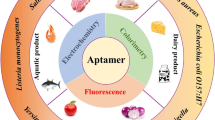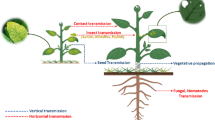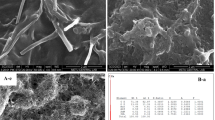Abstract
The developed method for simultaneous detection of aflatoxin B1 (AFB1) and aflD genes can effectively monitor from the source and reduce the safety problems and economic losses caused by the production of aflatoxin, which can be of great significance for food safety regulations. In this paper, we constructed a sensitive and convenient fluorescent biosensor to detect AFB1 and aflD genes simultaneously based on fluorescence resonance energy transfer (FRET) between quantum dots (QDs) and a black hole quenching agent. A stable “Y” shaped aptasensor was employed as the detection platform and a double quantum dot labeled DNA fragment was utilized to be the sensing element in this work. When the targets of AFB1 and aflD genes were presented in the solution, the aptamer in the “Y” shaped probe is specifically recognized by the target. At this time, both Si-carbon quantum dots (Si-CDs) and CdTe QDs are far away from the BHQ1 and BHQ3 to recover the fluorescence. The linear range of the prepared fluorescence simultaneous detection method was as wide as 0.5–500 ng·mL−1 with detection lines of 0.64 ng·mL−1 for AFB1 and 0.5–500 nM with detection lines of 0.75 nM for aflD genes (3σ/k). This fabricated fluorescent biosensor was further validated in real rice flour and corn flour samples, which also achieved good results. The recoveries were calculated by comparing the known and found amounts of AFB1 which ranged from 88.4 to approximately 115.32% in the rice flour samples and 90.7 ~ 102.58% in the corn flour samples. The recoveries of aflD genes ranged from 84.32 to approximately 109.3% in the rice flour samples and 89.48 ~ 100.99% in the corn flour samples. Therefore, the proposed biosensor can significantly improve food safety and quality control through a simple, fast, and sensitive agricultural product monitoring and detection system.
Graphical abstract






Similar content being viewed by others
Data availability
The data that support the findings of this study are available from the corresponding author upon reasonable request.
References
Kabak B, Dobson ADW, Var I. Strategies to prevent mycotoxin contamination of food and animal feed: a review. Crit Rev Food Sci Nutr. 2006;46:593–619. https://doi.org/10.1080/10408390500436185.
Xiong ZW, Wang Q, Xie YJ, Li N, Yun W, Yang LZ. Simultaneous detection of aflatoxin B1 and ochratoxin A in food samples by dual DNA tweezers nanomachine. Food Chem. 2021;338: 128122. https://doi.org/10.1016/j.foodchem.2020.128122.
Zhou SY, Xu LG, Kuang H, Xiao J, Xu CL. Immunoassays for rapid mycotoxin detection: state of the art. Analyst. 2020;145:7088–102. https://doi.org/10.1039/d0an01408g.
Fan Y, Li J, Amin K, Yu H, Yang HH, Guo ZJ, Liu JS. Advances in aptamers, and application of mycotoxins detection: a review. Food Res Int. 2023;170: 113022. https://doi.org/10.1016/j.foodres.2023.113022.
De Boevre M, Di Mavungu JD, Landschoot S, Audenaert K, Eeckhout M, Maene P, Haesaert G, De Saeger S. Natural occurrence of mycotoxins and their masked forms in food and feed products. World Mycotoxin J. 2012;5:207–19. https://doi.org/10.3920/wmj2012.1410.
Pereira VL, Fernandes JO, Cunha SC. Mycotoxins in cereals and related foodstuffs: a review on occurrence and recent methods of analysis. Trends Food Sci Tech. 2014;36:96–136. https://doi.org/10.1016/j.tifs.2014.01.005.
Ostry V, Malir F, Toman J, Grosse Y. Mycotoxins as human carcinogens—the IARC Monographs classification. Mycotoxin Res. 2016;33:65–73. https://doi.org/10.1007/s12550-016-0265-7.
Freire L, Sant’Ana AS, Modified mycotoxins: an updated review on their formation, detection, occurrence, and toxic effects. Food Chem Toxicol. 2018;111:189-205. https://doi.org/10.1016/j.fct.2017.11.021.
Abia WA, Warth B, Sulyok M, Krska R, Tchana AN, Njobeh PB, Dutton MF, Moundipa PF. Determination of multi-mycotoxin occurrence in cereals, nuts and their products in Cameroon by liquid chromatography tandem mass spectrometry (LC-MS/MS). Food Control. 2013;31:438–53. https://doi.org/10.1016/j.foodcont.2012.10.006.
Var I, Kabak B, Gök F. Survey of aflatoxin B1 in helva, a traditional Turkish food, by TLC. Food Control. 2007;18:59–62. https://doi.org/10.1016/j.foodcont.2005.08.008.
Pietri A, Fortunati P, Mulazzi A, Bertuzzi T. Enzyme-assisted extraction for the HPLC determination of aflatoxin M1 in cheese. Food Chem. 2016;192:235–41. https://doi.org/10.1016/j.foodchem.2015.07.006.
da Luz SR, Pazdiora PC, Dallagnol LJ, Dors GC, Chaves FC. Mycotoxin and fungicide residues in wheat grains from fungicide-treated plants measured by a validated LC-MS method. Food Chem. 2017;220:510–6. https://doi.org/10.1016/j.foodchem.2016.09.180.
Qian J, Ren CC, Wang CQ, Chen W, Lu XT, Li HN, Liu Q, Hao N, Li HM, Wang K. Magnetically controlled fluorescence aptasensor for simultaneous determination of ochratoxin A and aflatoxin B1. Anal Chim Acta. 2018;1019:119–27. https://doi.org/10.1016/j.aca.2018.02.063.
Pehlivan ZS, Torabfam M, Kurt H, Ow-Yang C, Hildebrandt N, Yüce M. Aptamer and nanomaterial based FRET biosensors: a review on recent advances (2014–2019). Microchim Acta. 2019;186:1–22. https://doi.org/10.1007/s00604-019-3659-3.
Zhang WQ, Ling J, Wen D, Cheng ZJ, Wang SP, Ding YJ. Simultaneous detection of acute myocardial infarction -related miR-199a and miR-499 based on a dual-emission CdTe fluorescent probe and T7 exonuclease-assisted signal amplification. Sens Actuators B Chem. 2022;371: 132484. https://doi.org/10.1016/j.snb.2022.132484.
Suo ZG, Liang XJ, Jin HL, He BS, Wei M. A signal-enhancement fluorescent aptasensor based on the stable dual cross DNA nanostructure for simultaneous detection of OTA and AFB1. Anal Bioanal Chem. 2021;413:7587–95. https://doi.org/10.1007/s00216-021-03723-8.
Kesharwani P, Ma RY, Sang L, Fatima M, Sheikh A, Abourehab MAS, Gupta N, Chen Z-S, Zhou Y. Gold nanoparticles and gold nanorods in the landscape of cancer therapy. Mol Cancer. 2023;22:98–128. https://doi.org/10.1186/s12943-023-01798-8.
Liu Z, Tao J, Zhu Z, Zhang Y, Wang H, Pang P, Wang H, Yang W. A sensitive electrochemical assay for T4 polynucleotide kinase activity based on Fe3O4@TiO2 and gold nanoparticles hybrid probe modified magnetic electrode. J Electrochem Soc. 2022;169: 027504. https://doi.org/10.1149/1945-7111/ac4f6c.
Maiti P, Sarkar S, Singha T, Dutta Roy S, Mahato M, Karmakar P, Paul S, Paul PK. Enhancement of fluorescence mediated by silver nanoparticles: implications for cell imaging. Langmuir. 2023;39:6713–29. https://doi.org/10.1021/acs.langmuir.3c00204.
Luo YS, Liu F, Li EZ, Fang Y, Zhao G, Dai X, Li JJ, Wang B, Xu MY, Liao B, Sun GP. FRET-based fluorescent nanoprobe platform for sorting of active microorganisms by functional properties. Biosens Bioelectron. 2020;148: 111832. https://doi.org/10.1016/j.bios.2019.111832.
Qian J, Cui HN, Lu XT, Wang CQ, An KQ, Hao N, Wang K. Bi-color FRET from two nano-donors to a single nano-acceptor: a universal aptasensing platform for simultaneous determination of dual targets. Chem Eng J. 2020;401: 126017. https://doi.org/10.1016/j.cej.2020.126017.
Li JZ, Zhao XD, Wang Y, Li S, Qin YK, Han T, Gao ZX, Liu H. A highly sensitive immunofluorescence sensor based on bicolor upconversion and magnetic separation for simultaneous detection of fumonisin B1 and zearalenone. Analyst. 2021;146:3328–35. https://doi.org/10.1039/d1an00004g.
Qin YK, Li S, Wang Y, Peng Y, Han DP, Zhou HY, Bai JL, Ren SY, Li S, Chen RP, Han T, Gao ZX. A highly sensitive fluorometric biosensor for Fumonisin B1 detection based on upconversion nanoparticles-graphene oxide and catalytic hairpin assembly. Anal Chim Acta. 2022;1207: 339811. https://doi.org/10.1016/j.aca.2022.339811.
Liang M, Lei ZL, Li YL, Xiao Y. A simple strategy to enhance the luminescence of metal nanoclusters and its application for turn-on detection of 2-thiouracil and hyaluronidase. Talanta. 2022;236: 122876. https://doi.org/10.1016/j.talanta.2021.122876.
Wang H-B, Tao B-B, Wu N-N, Zhang H-D, Liu Y-M. Glutathione-stabilized copper nanoclusters mediated-inner filter effect for sensitive and selective determination of p-nitrophenol and alkaline phosphatase activity. Spectrochim Acta A Mol Biomol Spectrosc. 2022;271: 120948. https://doi.org/10.1016/j.saa.2022.120948.
Ruscito A, DeRosa MC. Small-molecule binding aptamers: selection strategies, characterization, and applications. Front Chem. 2016;4:14–27. https://doi.org/10.3389/fchem.2016.00014.
Dong ZY, Zhang Q, Chen B-Y, Hong JM. Oxidation of bisphenol A by persulfate via Fe3O4-α-MnO2 nanoflower-like catalyst: mechanism and efficiency. Chem Eng J. 2019;357:337–47. https://doi.org/10.1016/j.cej.2018.09.179.
Zhuo ZJ, Yu YY, Wang ML, Li J, Zhang ZK, Liu J, Wu XH, Lu AP, Zhang G, Zhang BT. Recent advances in SELEX technology and aptamer applications in biomedicine. Int J Mol Sci. 2017;18:2142. https://doi.org/10.3390/ijms18102142.
Khan ZG, Patil PO. A comprehensive review on carbon dots and graphene quantum dots based fluorescent sensor for biothiols. Microchem J. 2020;157: 105011. https://doi.org/10.1016/j.microc.2020.105011.
Shao XL, Zhu LJ, Feng YX, Zhang YZ, Luo YB, Huang KL, Xu WT. Detachable nanoladders: a new method for signal identification and their application in the detection of ochratoxin A (OTA). Anal Chim Acta. 2019;1087:113–20. https://doi.org/10.1016/j.aca.2019.08.057.
Dunn MR, Jimenez RM. Chaput JC, Analysis of aptamer discovery and technology. Nat Rev Chem. 2017;1:0076. https://doi.org/10.1038/s41570017-0076.
Zhu WT, Zhou YS, Liu S, Luo M, Du J, Fan JP, Xiong H, Peng HL. A novel magnetic fluorescent molecularly imprinted sensor for highly selective and sensitive detection of 4-nitrophenol in food samples through a dual-recognition mechanism. Food Chem. 2021;348: 129126. https://doi.org/10.1016/j.foodchem.2021.129126.
Gao JW, Chen ZY, Mao LB, Zhang W, Wen W, Zhang XH, Wang SF. Electrochemiluminescent aptasensor based on resonance energy transfer system between CdTe quantum dots and cyanine dyes for the sensitive detection of ochratoxin A. Talanta. 2019;199:178–83. https://doi.org/10.1016/j.talanta.2019.02.044.
Lu ZS, Chen XJ, Wang Y, Zheng XT, Li CM. Aptamer based fluorescence recovery assay for aflatoxin B1 using a quencher system composed of quantum dots and graphene oxide. Microchim Acta. 2014;182:571–8. https://doi.org/10.1007/s00604-014-1360-0.
Deng HP, Liu QW, Wang X, Huang R, Liu HX, Lin QM, Zhou XM, Xing D. Quantum dots-labeled strip biosensor for rapid and sensitive detection of microRNA based on target-recycled nonenzymatic amplification strategy. Biosens Bioelectron. 2017;87:931–40. https://doi.org/10.1016/j.bios.2016.09.043.
Kumar YVVA, Renuka RM, Achuth J, Mudili V, Poda S. Development of a FRET-based fluorescence aptasensor for the detection of aflatoxin B1 in contaminated food grain samples. RSC Adv. 2018;8:10465-10473. https://doi.org/10.1039/c8ra00317c.
Zhu J, Wang SN, Li JJ, Zhao JW. The effect of core size on the fluorescence emission properties of CdTe@CdS core@shell quantum dots. J Lumin. 2018;199:216–24. https://doi.org/10.1016/j.jlumin.2018.03.047.
Wang YF, Wang K, Han ZX, Yin ZM, Zhou CJ, Du FL, Zhou SY, Chen P, Xie Z. High color rendering index trichromatic white and red LEDs prepared from silane-functionalized carbon dots. J Mater Chem C. 2017;5:9629–37. https://doi.org/10.1039/c7tc02297b.
Liu T, Fu LX, Yin CH, Wu M, Chen LG, Niu N. Design of smartphone platform by ratiometric fluorescent for visual detection of silver ions. Microchem J. 2022;174: 107016. https://doi.org/10.1016/j.microc.2021.107016.
Ma Q, Nie DQ, Sun XY, Xu YL, He JX, Yang L, Yang LZ. A versatile Y shaped DNA nanostructure for simple, rapid and one-step detection of mycotoxins. Spectrochim Acta A Mol Biomol Spectrosc. 2022;281: 121634. https://doi.org/10.1016/j.saa.2022.121634.
Hu O, Li ZY, Tong YL, Wang QY, Chen ZG. DNA functionalized double quantum dots-based fluorescence biosensor for one-step simultaneous detection of multiple microRNAs. Talanta. 2021;235: 122763. https://doi.org/10.1016/j.talanta.2021.122763.
Guo P, Yang W, Hu H, Wang Y, Li P. Rapid detection of aflatoxin B1 by dummy template molecularly imprinted polymer capped CdTe quantum dots. Anal Bioanal Chem. 2019;411:2607–17. https://doi.org/10.1007/s00216-019-01708-2.
Chen L, Wen F, Li M, Guo X, Li S, Zheng N, Wang J. A simple aptamer-based fluorescent assay for the detection of aflatoxin B1 in infant rice cereal. Food Chem. 2017;215:377–82. https://doi.org/10.1016/j.foodchem.2016.07.148.
Wang C, Yu H, Zhao Q. A simple structure-switch aptasensor using label-free aptamer for fluorescence detection of aflatoxin B1. Molecules. 2022;27:1–9. https://doi.org/10.3390/molecules27134257.
Sedighi-Khavidak S, Mazloum-Ardakani M, Rabbani Khorasgani M, Emtiazi G, Hosseinzadeh L. Detection of aflD gene in contaminated pistachio withAspergillus flavusby DNA based electrochemical biosensor. Int J Food Prop. 2017;20:S119–30. https://doi.org/10.1080/10942912.2017.1291675.
Li Y, Yu T, Li J, Kong D, Shi Q, Liu C, Dong C. A novel fluorescent FRET hairpin probe switch for aflD gene detection in real fermented soybean paste. Food Anal Methods. 2021;14:2469–77. https://doi.org/10.1007/s12161-021-02080-7.
Yu T, Peng S, Sun Q, Kong D, Liu C, Shi Q, Li Y, Chen Y, Fluorescence resonance energy transfer biosensor based on nitrogen doped carbon quantum dots and hairpin probe to sensitively detect aflatoxin biosynthesis-related genes aflD in rice. Res Sq 2022;1–15. https://doi.org/10.21203/rs.3.rs-1814775/v1.
Funding
This work was supported by the National Natural Science Foundation of China (No. 31901799, 32001804), the China Postdoctoral Science Foundation (No. 2021M692370), the JUST Emerging Science and Technology Innovation Team Grant (No. 1182921902), the Jiangsu Dual Innovation Talent Program (No. 1184902001), and the Jiangsu University of Science and Technology Research Start-up Fund (No. 1182932001, 1182922001).
Author information
Authors and Affiliations
Contributions
Yaqi Li: funding acquisition, conceptualization, writing, review and editing. Qingyue Sun: conceptualization, investigation, writing—original draft. Xin Chen: the main strengths in the stage of article revision including synthesis and preparation new quantum dot probes, data analysis, and literature searching and organization. Shuangfeng Peng: data curation, formal analysis. Dezhao Kong: supervision. Chang Liu: validation. Qi Zhang and Qiaoqiao Shi: methodology. Yong Chen: supervision.
Corresponding authors
Ethics declarations
Conflict of interest
The authors declare no competing interests.
Additional information
Publisher's Note
Springer Nature remains neutral with regard to jurisdictional claims in published maps and institutional affiliations.
Supplementary Information
Below is the link to the electronic supplementary material.
Rights and permissions
Springer Nature or its licensor (e.g. a society or other partner) holds exclusive rights to this article under a publishing agreement with the author(s) or other rightsholder(s); author self-archiving of the accepted manuscript version of this article is solely governed by the terms of such publishing agreement and applicable law.
About this article
Cite this article
Li, Y., Sun, Q., Chen, X. et al. Simultaneous detection of AFB1 and aflD gene by “Y” shaped aptamer fluorescent biosensor based on double quantum dots. Anal Bioanal Chem 416, 883–893 (2024). https://doi.org/10.1007/s00216-023-05074-y
Received:
Revised:
Accepted:
Published:
Issue Date:
DOI: https://doi.org/10.1007/s00216-023-05074-y




